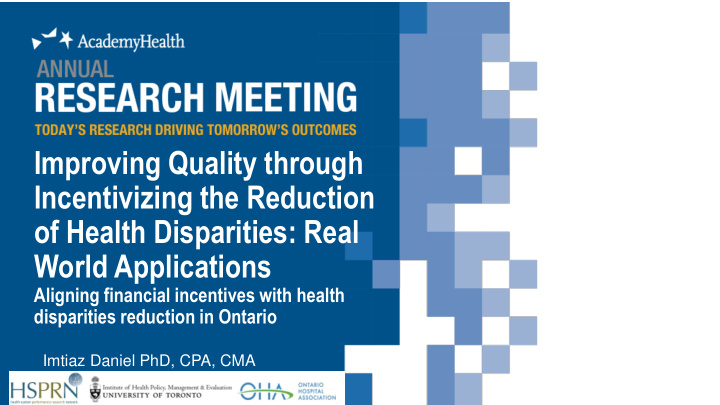



1 Improving Quality through Incentivizing the Reduction of Health Disparities: Real World Applications Aligning financial incentives with health disparities reduction in Ontario Imtiaz Daniel PhD, CPA, CMA
2 The Ontario Hospital System 2 Population: 13,982,984 Ontario is the fourth largest province by total area of 1.1million square kms Ontario is in east-central Canada and Funding flows from the government to borders the US and the Great Lakes. 14 health regions. These health regions also have accountability The 145 hospitals in Ontario are agreements with relevant hospitals. primarily publically financed from the provincial government. They privately 18 billion dollars goes towards the deliver care. public financing of Ontario hospitals .
3 Quick Facts on Ontario’s Hospital System 3
4 Funding in the Past 4 Health Service Providers received 75-90% of their funding in lump sums (global budgets) Few opportunities to change funding to meet • the demands of the populations being served • Little incentive to improve performance or quality Source: HSFR Governance
5 Excellent Care for all Act 2010 5
6 Ontario Context: 6 Health System Funding Reform (HSFR) Introduced in 2012 Global Funding
7 Health System Funding Reform Goals 7 Reflects the needs of the community Equitable allocation of healthcare dollars HSFR’s goals and Better quality care and improved outcomes objectives are translated Moderate spending growth to into activity-based funding sustainable levels model components Adopt/learn from approaches used in other jurisdictions Phased in over time at a managed pace
8 Goals : Health System Funding Reform 8 Source: HSFR Governance
9 9 Health System Funding Reform Goal $8.4B 52.4% $2.4B 15.4% $5.1B; 32.3% Source: HSFR Governance
10 Activity-Based Funding (ABF) Models 10 in Ontario A movement towards efficiency and hospital funding equity Health-Based Allocation Model • Estimates future expense based on past service levels and efficiency • Utilizes population and health information (e.g., age, gender, income, population growth rates) as adjustments • Expenses are adjusted for rurality
11 Activity-Based Funding (ABF) Models 11 in Ontario Quality-Based Procedures • Clusters of patients with clinically related diagnoses/ treatments and functional needs identified by an evidence-based framework. • Provides opportunity for: ✓ Aligning incentives to facilitate adoption of best practices ✓ Appropriately reducing variation in costs and practice while improving outcomes
12 Clinical Handbooks 12 Health Quality Ontario website: http://www.hqontario.ca/Quality-Improvement/Our-Programs/QBP-Connect Source: HSFR Governance
13 Healthcare Equity and 13 Ontario Hospital Funding For HSFR Hospitals (N=75), there are some adjustments within the ABF models: ✓ Age ✓ Gender ✓ Socioeconomic Status (estimated using neighbourhood income quintiles available from Statistics Canada) ✓ Rurality There are no adjustments for globally-funded non-HSFR hospitals (N=70)
14 Healthcare Equity and 14 Ontario Hospital Funding Even with the adjustments within HSFR ABF formulas: • There are known healthcare inequities that are difficult to target using a formulaic funding approach (e.g., access to care). • In Ontario, our Aboriginal populations (many of which are located close to small, northern globally-funded hospitals) • Addressing this healthcare inequity is particularly difficult due to a complex policy environment: • the federal government is responsible for financing healthcare provided to Aboriginal populations • the provincial government provide hospital care, physician funding, and public health programs for all Canadians, including First Nations, Inuit, and Métis populations, but generally do not operate direct health services for First Nations on-reserve or for Inuit communities.
15 Health Inequity in the Northern Ontario 15 • Populations in the north – First Nations, Metis and Inuit. (18.3% in NW Region and 11% in NE) • Substantial differences in the way health care is funded and delivered for First Nations, Métis and Inuit peoples in Ontario • Francophone populations • More than one in five people (21.6%) in the North East LHIN region identify French as their first official language spoken, which is more than five times the Ontario rate of 3.9%.
16 Canada-wide: Income-Related 16 Health Inequalities • Recent report found income inequality has widened over time in Canada for 3 health indicators • Smoking • COPD hospitalizations age<75 • Self-Rated Mental Health • Inequalities are large (e.g., Smoking, Diabetes, Self-Rated Mental Health, Mental Illness Hospitalization, Alcohol-Attributable Hospitalization, Infant Mortality) • Health determinants primarily affect lower- income groups (e.g., Core Housing Need, Homelessness, Household Food Insecurity)
17 Ontario’s Rural Communities 17 • 61 Small hospitals with less than 4,000 inpatient weighted cases. Urban/ CMA/CA Community Size Legend Rural Large Primary Core Large Secondary Core Medium Primary Core Urban CMA Medium Secondary Core Small Secondary Core Small Fringe Rural Medium Primary Core Medium Secondary Core Urban Small Primary Core CA Small Secondary Core Small Fringe Rural Strong MIZ Moderate Urban Not Weak MIZ CMA/CA No MIZ Rural
18 Funding Reform Evolution in Ontario 18 • A stronger focus on quality, • Establish special purpose including targeted interventions funding targeting limited to improve healthcare equity populations where there are known inequities (e.g., Aboriginal populations) • Establish a measure of health need using stratified data by: Age • Sex • Geographic • Consider the location • Income • Education • implementation of Aboriginal identity • innovative models of care to Ethnicity/racial groups address inequities, including care models that integrate health and social care. • Leverage existing equity work Interventions should be and align hospital funding and developed in consultation service equity strategy of with target populations underserviced populations to ensure patient/provider interactions are effective
19 Acknowledgements 19 Contact: Imtiaz.Daniel@utoronto.ca idaniel@oha.com @Imtiaz.daniel
Recommend
More recommend